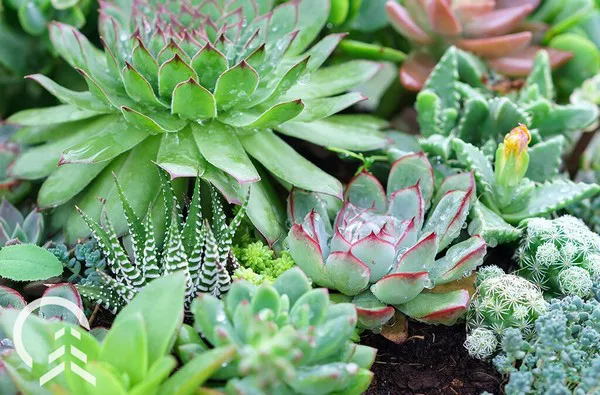Succulents have captured the hearts of plant enthusiasts worldwide with their unique shapes, vibrant colors, and remarkable adaptability to various environments. These hardy plants, known for their ability to store water in their leaves, stems, or roots, have a rich and diverse history that spans continents and centuries.
Ancient Beginnings in Africa
The roots of succulents can be traced back to the arid landscapes of Africa, where these resilient plants first took root. The vast continent is home to a wide array of succulent species, each adapted to thrive in specific regions with unique climate conditions. From the spiky aloes of South Africa to the fleshy euphorbias of the Sahara Desert, succulents have evolved to survive in environments where water is scarce, and temperatures can be extreme.
The survival strategies of succulents, such as storing water in specialized tissues, allowed them to withstand the challenges posed by Africa’s diverse ecosystems. Over time, these adaptations became defining features of succulents, shaping their evolution and paving the way for their eventual spread to other parts of the world.
Migration Across Continents
While Africa served as the cradle of succulents, these hardy plants did not remain confined to their continent of origin. The migration of succulents to other continents occurred through a combination of natural processes and human intervention.
One of the most notable examples of succulent migration is the spread of certain cactus species from the Americas to Africa. Through ocean currents and bird migration, cactus seeds found their way across the Atlantic Ocean, establishing themselves in parts of Africa. This intercontinental journey showcases the remarkable adaptability of succulents and their ability to colonize new territories.
Colonization of the Americas
In the Americas, succulents found diverse habitats ranging from the deserts of North America to the rainforests of Central and South America. Cacti, a prominent group of succulents, became emblematic of North American deserts, thriving in conditions where other plants struggled to survive.
The iconic saguaro cactus, with its towering arms, became synonymous with the American Southwest, while the prickly pear cactus adorned arid landscapes from Mexico to the United States. These succulents played crucial roles in the ecosystems they inhabited, providing sustenance to wildlife and indigenous communities.
Adaptations to Extreme Environments
The success of succulents in colonizing diverse environments is attributed to their ability to adapt to extreme conditions. From the high-altitude deserts of South America to the coastal cliffs of the Mediterranean, succulents have demonstrated their resilience in the face of challenging climates.
Succulents in desert regions, such as the agaves of Mexico and the lithops of southern Africa, have evolved unique features like water-storing leaves and reduced surface areas to minimize water loss through transpiration. These adaptations allow succulents to thrive in regions where rainfall is sporadic, and temperatures can vary dramatically.
Cultural Significance and Horticultural Spread
Beyond their natural habitats, succulents have played significant roles in the cultures and traditions of various societies. Indigenous communities in Africa and the Americas utilized succulents for medicinal purposes, food, and materials for construction. The agave plant, for instance, holds cultural importance for many Native American tribes, who use it for food, fiber, and ritualistic purposes.
In the 19th and 20th centuries, succulents gained popularity in horticulture as collectors and enthusiasts began to appreciate their unique forms and low-maintenance requirements. The appeal of succulents transcended geographical boundaries, leading to the establishment of botanical gardens, nurseries, and horticultural societies dedicated to the cultivation and conservation of these fascinating plants.
Modern Succulent Diversity and Global Appeal
Today, succulents have become a global phenomenon, adorning gardens, homes, and urban spaces across continents. The resurgence of interest in succulents can be attributed to their aesthetic appeal, versatility, and suitability for modern lifestyles. With a diverse array of species, including the iconic aloe, echeveria, and haworthia, succulents have become staples in the world of interior design, landscaping, and social media.
The ease of propagation and the ability of succulents to thrive in containers have further fueled their popularity. From small apartment balconies to expansive desert gardens, succulents have found a place in the hearts and spaces of people from all walks of life.
Conservation Challenges and Efforts
While succulents have captivated the global gardening community, many species face threats in their native habitats. Habitat destruction, climate change, and illegal collection for the horticultural trade have led to the decline of some succulent populations. Conservation efforts, spearheaded by botanical gardens, environmental organizations, and passionate individuals, aim to protect endangered succulent species and their ecosystems.
International collaborations focus on sustainable horticulture practices, habitat restoration, and raising awareness about the importance of preserving the diversity of succulents and their natural habitats. Through these initiatives, there is hope for the continued survival and thriving of succulents in their native environments.
Conclusion
The journey of succulents from their ancient beginnings in Africa to their global prominence today is a testament to their resilience, adaptability, and enduring appeal. From the arid landscapes that shaped their evolution to the diverse environments they now inhabit, succulents continue to captivate and inspire plant enthusiasts worldwide.
As we appreciate the beauty of succulents in our gardens and homes, it’s essential to acknowledge their ecological importance and the need to conserve their natural habitats. The story of succulents is an ongoing narrative, with each generation contributing to the legacy of these remarkable plants. As we cultivate and cherish succulents, we become stewards of their history, ensuring that their journey through time and space continues to be one of wonder, admiration, and conservation.


